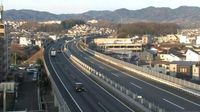On April 6, 2025, a significant failure in the Electronic Toll Collection (ETC) system disrupted traffic on several major expressways in Japan, including the Tomei Expressway, Chuo Expressway, and Isewangan Expressway. The incident occurred shortly before 00:30, leading to a series of toll booth closures and lane restrictions that affected numerous drivers across the region.
According to NEXCO Central Japan, the ETC system failure resulted in the closure of both Smart Interchanges (SIC) and Interchanges (IC) on the affected expressways. Restoration of the system is anticipated to take considerable time, leaving many travelers to navigate through general lanes and support lanes instead. However, this alternative has not been without its challenges, as congestion has been reported in various areas.
As of 11:00 AM on April 6, the following SICs were confirmed closed: Ashigara SIC, Komakado SIC, Aichi Toyoda SIC, and Fujikawa SIC on the Tomei Expressway, with the closures starting as early as 04:30. Additionally, the Toyoda Kamigo SIC exit was closed from 05:10. On the Shin-Tomei Expressway, the Gamagori Mikawa Gamagori SIC was also closed from 04:30.
On the Chuo Expressway, multiple SICs were affected, including Fuchu SIC, Doshi Sakawa SIC, Fuefuki Yatsushiro SIC, and Futaba SIC, all of which were closed from 01:20. The Fujiyoshida Nishi Katsura SIC and Fujiyoshida Shinobu no Sato SIC also experienced closures from the same time on the Fujiyoshida Line and Higashi Fuji Five Lakes Road.
Other notable closures included Anpachi SIC on the Meishin Expressway at 08:10, Kariya SIC on the Isewangan Expressway at 05:10, and Suzuka SIC on the Shin-Meishin Expressway from 01:05. The Tokai Kanjo Expressway reported the closure of Gobo SIC and Kutsukake SIC from 07:00 and 10:00, respectively.
As for the ETC lanes, by 11:00 AM, they were reported unavailable at several ICs, leading drivers to rely on general lanes. This included major ICs such as Fuji IC, Shimizu IC, Toyokawa IC, and Nagoya IC on the Tomei Expressway, among others. The Shin-Tomei Expressway also saw disruptions at Nagaizumi Numazu IC and Shin-Fuji IC, while the Chuo Expressway faced challenges at Takaiwa IC and Hachioji IC, to name a few.
In a related incident, the Japan Road Traffic Information Center reported that an ETC system failure occurred on the Chuo Expressway at around 00:24 on the same day, compounding the traffic issues. This failure led to the closure of various toll booths in Tokyo and Yamanashi Prefecture, with some toll booths still processing traffic through general lanes.
By 06:00 AM, traffic congestion had reached approximately 1 km near the Mitaka toll booth on the inbound Chuo Expressway, and the estimated time for restoration remained uncertain. Drivers were advised to stay updated on the latest traffic information and to follow detour instructions as they navigated through the affected areas.
The widespread impact of the ETC system failure has raised concerns among commuters and transport authorities alike. With many relying on these expressways for daily travel and logistics, the repercussions of this disruption are likely to be felt for some time. Authorities are working diligently to resolve the technical issues and restore normal operations.
As the situation unfolds, travelers are encouraged to remain patient and informed. The use of general lanes may lead to longer wait times, but it remains a viable option for those needing to reach their destinations. The ongoing challenges highlight the importance of reliable infrastructure in maintaining smooth traffic flow and the need for contingency plans in the event of system failures.
As of now, NEXCO Central Japan and the Japan Road Traffic Information Center continue to monitor the situation closely, providing updates as they become available. Commuters are reminded to check traffic advisories regularly and to plan their routes accordingly to avoid unnecessary delays.





